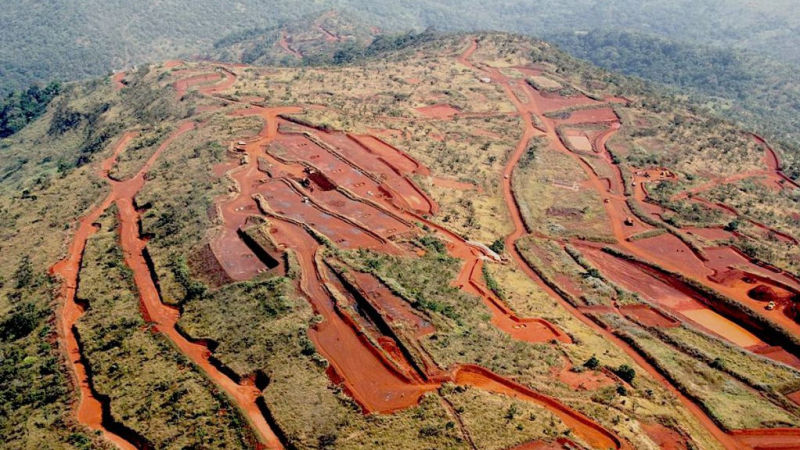Financiers warned of huge risks to communities and biodiversity as Rio Tinto approves world’s biggest mining project
- emyloia7
- Feb 26, 2024
- 4 min read
Feb 26 2024 | Accra, Ghana and Nijmegen, Netherlands
By: BankTrack & Advocates for Community Alternatives (ACA)
Contact:
Ryan Brightwell, Research and Communications Director, BankTrack, +31 634 643 116
Emyloïa Kpadonou, Communications Officer, Advocates for Community Alternatives, +233 50 037 5984

The Board of Directors of Anglo-Australian mining giant Rio Tinto is exposing Guinean communities and the company’s shareholders to grave risks by approving a $6.2 billion investment in the Simandou iron project without adequately studying and mitigating environmental and social risks, according to civil society organisations BankTrack and Advocates for Community Alternatives.
The Simandou project involves four extensive mining blocks in a globally recognized biodiversity hotspot in southeastern Guinea, over 650 km of new rail lines traversing chimpanzee habitat and the territory of at least 450 communities, and a dedicated port facility in a coastal area where artisanal fishing comprises the main source of income and food security. While the project is still under construction, local communities have already reported widespread land theft, destruction of farmlands, profanation of cultural sites, pollution of sacred springs and drinking water sources, and degradation of fish stocks and other sources of livelihoods. (1)
Rio Tinto is one of the main developers of the project through its controlling stake in a local joint venture, Simfer S.A., that was granted rights to mine half the iron ore deposit. While much of the infrastructure for the project has been built by the holder of the other half of the mineral rights, the Chinese-led Winning Consortium Simandou (WCS), Simfer is the joint owner of the railway and the port.
“So far, Rio Tinto’s public commitments to strict social and environmental norms has been cold comfort to Guinean communities in the path of the Simandou project,” explained Jonathan Kaufman, Executive Director of Advocates for Community Alternatives. “As co-owners of the rail and port facilities, they could have put a stop to the abuses and ensured that affected people receive a remedy for what they’ve suffered, but they’ve done nothing.”
The project developers could mitigate the risks of the project if they properly studied and planned for them, but according to civil society advocates, both Simfer and WCS have failed to do so. (2)
BankTrack, together with partners, first raised the alarm about the risks and impacts of this project last summer by publishing a Dodgy Deal profile. The banks financing Rio Tinto and the other project developers were also warned in a November 2023 letter, in which they were reminded of their responsibilities under the United Nations Guiding Principles on Business and Human Rights and the OECD Guidelines for Multinational Enterprises. (3)
The pollution of waterways, failure to respect social and environmental commitments, and decision to start construction before environmental review was complete all constitute violations of Guinean law that could threaten Rio Tinto’s legal and social licenses to operate. They are also violations of the Equator Principles and the IFC Performance Standards, to which many international financial institutions have pledged adherence in their funding decisions. If the project results in an environmental and humanitarian disaster, as Human Rights Watch has warned it could, financiers that uncritically support Rio Tinto will find themselves complicit.
Banks funding Rio Tinto should therefore engage the company to ensure that harms so far experienced by communities are addressed, further risks are mitigated, and with the active participation of local communities. Specifically, banks should insist that Rio Tinto publicly commit to adhering to the IFC Performance Standards, submit to an independent audit under the IRMA standards for responsible mining, apply the principle of Free, Prior, and Informed Consent with respect to the affected communities, and publicly disclose key project documents, including impact assessments and audits and the project’s Environmental Compliance Certificates.
Notes to editors
(1) More information about the Simandou project’s risks and impacts can be found on BankTrack’s Dodgy Deal profile, here: https://www.banktrack.org/project/simandou_iron_ore_project_guinea
The profile includes up-to-date maps showing the project’s impacts on communities, protected areas, biodiversity hotspots and chimpanzee habitats produced by EarthInsight.
(2) WCS’s environmental and social impact assessments are dire; for example, they predict irreversible impacts to groundwater systems that supply local communities and flow into the headwaters of the Niger River, a lifeline to millions of people in several arid West African countries. But they are also inadequate; expert reviews have shown that they are based on outdated and inapplicable data, fail to include key mitigation plans for biodiversity and management of effluents, and dedicate insufficient funds for the preservation of endangered species such as the West African chimpanzee, the forest elephant, and the pygmy hippopotamus.
Rio Tinto’s own record of due diligence is no better; the company's original impact plan for preserving biodiversity relied on “physically removing or scaring away animals,” and its current assessments and plans have not been made public. In fact, Rio Tinto began clearing land and building its own section of railroad before its impact studies had ever been considered by the Guinean government.
(3) Letters were sent to 23 major financiers of Rio Tinto, for an example see here.

Comments